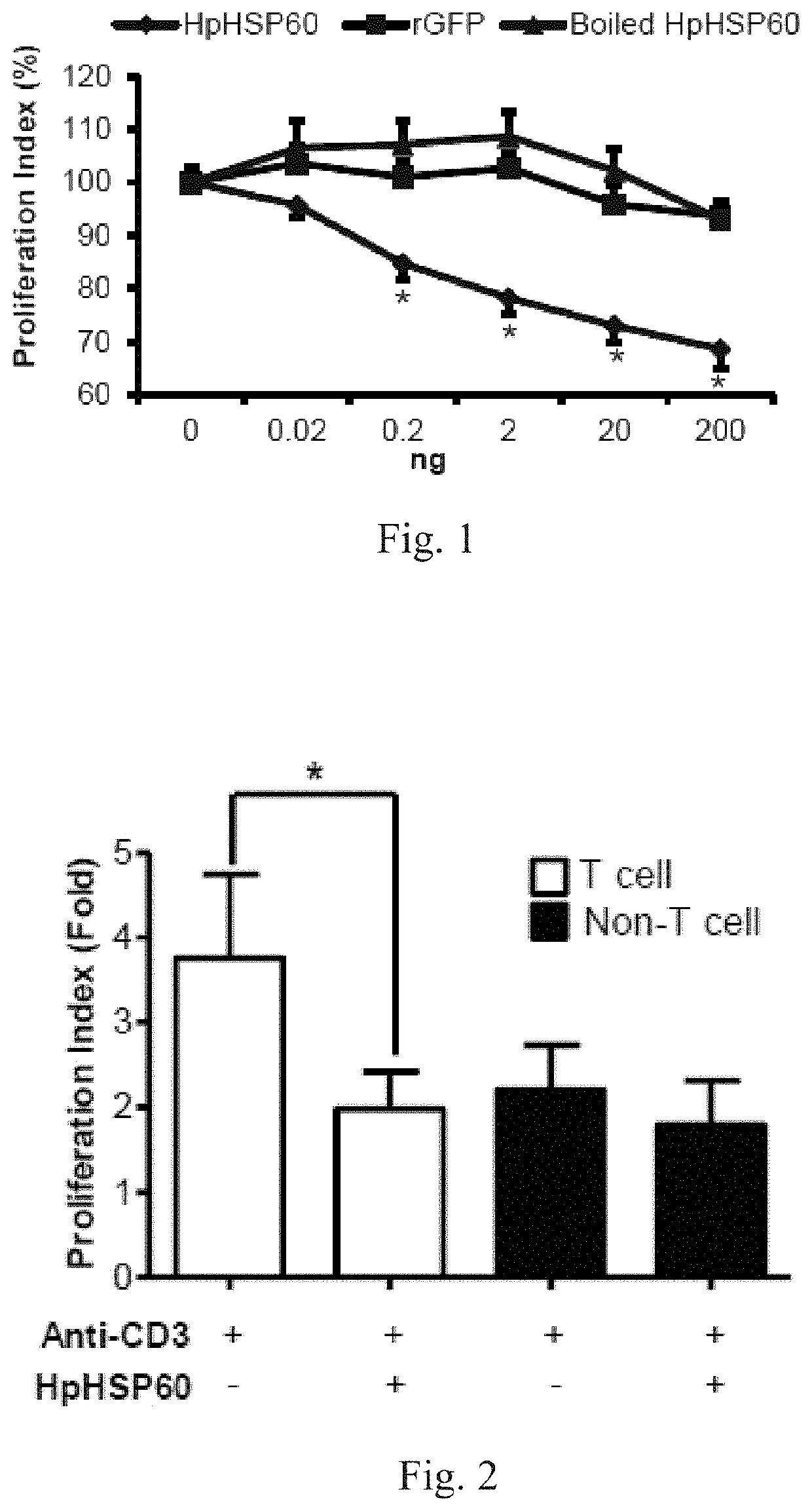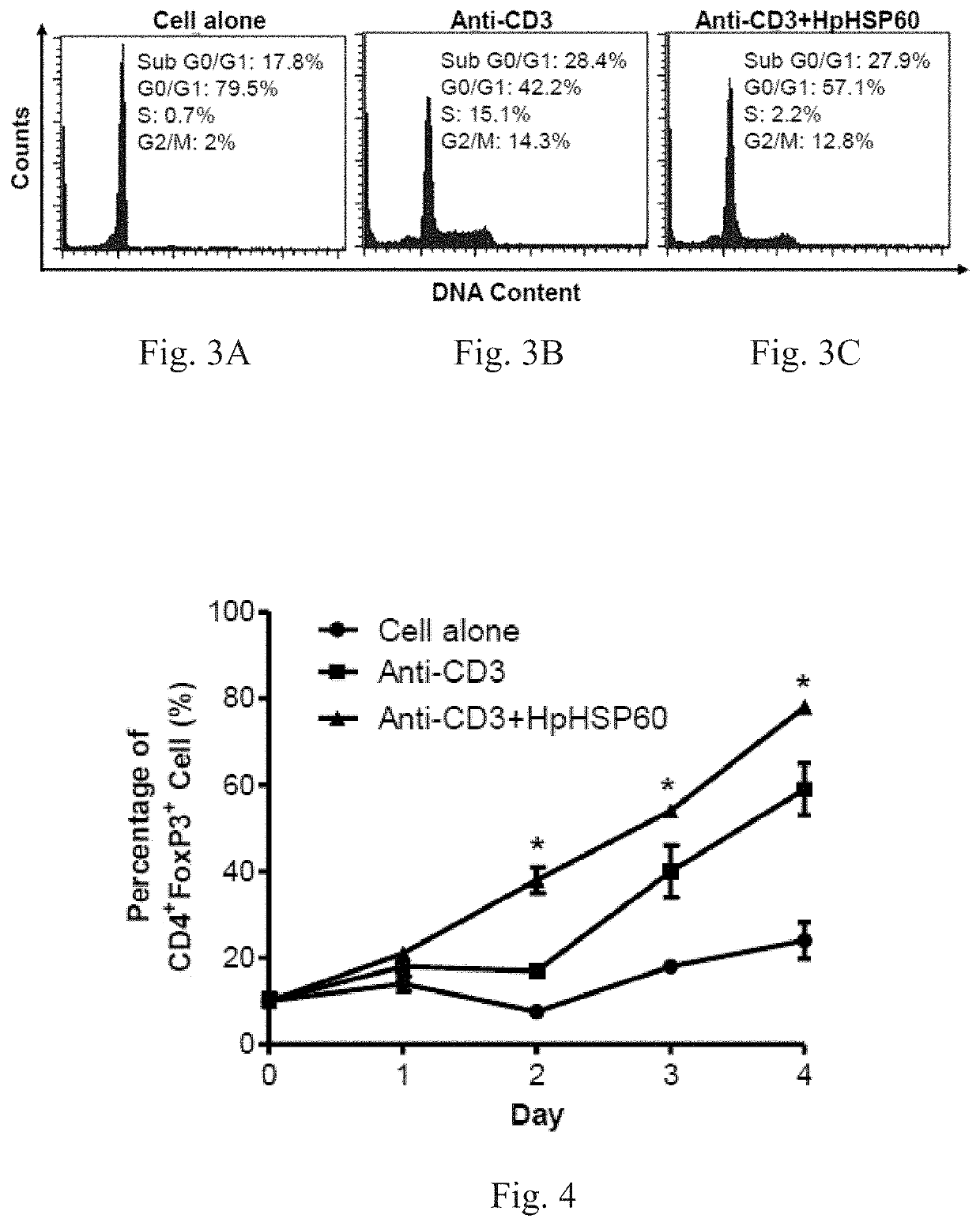Monoclonal antibody inhibiting immunosuppressive functions of pathogens, antigen-binding fragment thereof, and hybridomas producing such antibody
a technology of monoclonal antibodies and pathogens, which is applied in the field of monoclonal antibodies inhibiting antigen-binding fragments thereof, and hybridomas producing such antibodies, can solve the problems of affecting the growth of i, chronic infections and the development of gastric pathologies in certain patients, and suppressing the immunity of their hosts. , the effect of blocking the immunosuppressive functions of pathogens
- Summary
- Abstract
- Description
- Claims
- Application Information
AI Technical Summary
Benefits of technology
Problems solved by technology
Method used
Image
Examples
embodiment 1
Cell Culture and Isolation of PBMC and T-Cells
[0068]Human peripheral blood mononuclear cells (PBMCs) from healthy donors were isolated by density gradient centrifugation using Ficoll-Paque Plus (GE Healthcare, Uppsala, Sweden) and resuspended in RPMI-1640 with 10% inactivated fetal calf serum and 1% penicillin-streptomycin. For monocyte depletion, PBMCs were cultured in 10-cm dishes at a density of 106 / ml overnight for monocyte attachment. The suspended cells were then collected by centrifugation at 1500 rpm for 15 min. Total T-cells were isolated from PBMCs by negative selection using a magnetic sorting device (Miltenyi Biotec, Mass., USA). Briefly, PBMCs were incubated with a cocktail of biotin-conjugated antibodies, followed by microbead-conjugated anti-biotin Abs for magnetic depletion. T-cells were eluted according to the manufacturer's protocols.
embodiment 2
The Effect of HpHSP60 on PBMC Proliferation
[0069]Proliferation of anti-CD3 mAb-stimulated PBMCs treated with HpHSP60, rGFP or boiled HpHSP60 at different doses was monitored by a cell proliferation assay. To measure cell proliferation, 0.2 ml of cells at 1×106 cells / ml were seeded in each well of an anti-CD3 mAb-precoated 96-well microplate. Cell proliferation was determined by an MTT assay after 96 hours. Results are shown in FIG. 1: experimental results on effects of HpHSP60 on PBMC proliferation. Data shown therein are reported as the proliferation index.
[0070]The cell proliferation index was calculated as follows: Proliferation index (100%)=(OD595 of the anti-CD3+HpHSP60-treated cells) / (OD595 of the anti-CD3-treated cells)*100%. The results that differ significantly from the untreated group are indicated by *(p<0.05) (n=15).
[0071]In FIG. 1, (♦) shows proliferation of T-cells is inhibited, after HpHSP60 is added into the PBMC. (▪) shows rGFP, being a control protein in this exper...
embodiment 3
Influence of HpHSP60 on T-Cell Proliferation in PBMC
[0072]After treatment with anti-CD3 mAb, PBMCs were treated with or without HpHSP60 (200 ng). T-cells or non-T-cells in PBMCs were identified by CD3 surface marker staining. Cell number was then calculated following a flow cytometer analysis.
[0073]For CD3 surface marker staining, cells were harvested and stained with 1 μg mouse anti-human CD3 IgG mAbs (OKT3), followed by 0.5 μg rabbit anti-mouse IgG-FITC secondary Abs (Biolegend, Calif., USA). For FoxP3 intracellular staining, the cells were harvested and stained with mouse anti-human CD4-FITC mAbs (Biolegend, Calif., USA) prior to fixing and permeabilization, followed by intracellular staining with mouse anti-human FoxP3-PE mAbs (BD Biosciences, Mass., USA) according to the manufacturer's protocol. For the cell cycle assay, cells were harvested after 72 hours and 106 cells were fixed with 70% ice-cold ethanol. DNA was stained with DNA staining buffer (5% Triton-X 100, 0.1 mg / ml RN...
PUM
 Login to View More
Login to View More Abstract
Description
Claims
Application Information
 Login to View More
Login to View More - R&D
- Intellectual Property
- Life Sciences
- Materials
- Tech Scout
- Unparalleled Data Quality
- Higher Quality Content
- 60% Fewer Hallucinations
Browse by: Latest US Patents, China's latest patents, Technical Efficacy Thesaurus, Application Domain, Technology Topic, Popular Technical Reports.
© 2025 PatSnap. All rights reserved.Legal|Privacy policy|Modern Slavery Act Transparency Statement|Sitemap|About US| Contact US: help@patsnap.com



